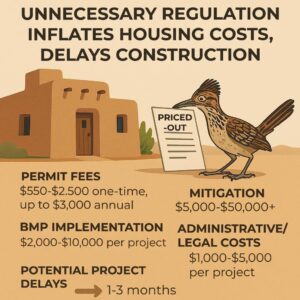New Mexico Home Builders Association Position Memo
October 2025
The draft rules propose a new state-level surface water permitting program under the New Mexico Water Quality Act, shifting authority from the EPA to the New Mexico Environment Department (NMED).
These proposed Rules are based upon keeping pollutants out of Waters of the United States (WOTUS), and based upon the 1902 Supreme Court ruling in US v. Rio Grande Dam & Irrigation Co., there are no WOTUS in the state. Therefore, there is no legal basis for applying the NMED-proposed rules to the construction industry in the state.
Adoption of these rules for our industry would increase housing costs without impacting water quality.
Read NMHBA position memo below. The New Mexico Environment Department (NMED) Surface Water Quality Bureau (SWQB) invites comment on draft amendments to the State’s
Ground and Surface Water Protection, at 20.6.2 New Mexico Administrative Code (NMAC) and NMED’s draft new rule to establish the New Mexico Pollutant Discharge Elimination System, at 20.6.5 NMAC. The public review and comment period for the draft amendments closes on October 28, 2025.
How to participate: CLICK to Comment
Comments will be accepted via mail, email, and NMED’s smart comment portal. Access the public review draft regulations on NMED’s website at https://www.env.nm.gov/surface-water-quality/spp/
__________________________________
Background and Legal Notes
1. The 2025 Legislative Session saw SB21 pass and signed into law to direct the NM Environment Department (NMED) to administer and enforce a permitting program to regulate discharges of pollutants into New Mexico’s rivers, streams, lakes and wetlands.
2. SB21 based its authority for adoption of a NM Pollution Discharge Elimination System (NMPDES) program on the federal Clean Water Act and its restrictions on release of pollutants into “Waters of the United States.”
3. On May 25, 2023 the U.S. Supreme Court issued its Sackett Ruling that clarified the definition of “Waters of the United States” (WOTUS) applied only to navigable waters that ran year-round for the purposes of interstate commerce and their contiguous wetlands.
4. In the Sackett Ruling there were numerous references to an earlier N.M. and U.S. Supreme Court Rulings in the US v. Rio Grande Dam & Irrigation Co. case. That case, which stretched from 1895 to 1902, ruled that time had run out for a group of English investors to build a dam across the Rio Grande and impound its waters, even though the Rio Grande was determined to not be navigable for interstate trade, as it dried up in the middle part of the state every year.
5. The U.S. government constructed Elephant Butte Reservoir in 1905 in its present location precisely because it was capable of handling the vast quantities of dirt and sand that washed down the Rio Grande each summer during the monsoon season, recognizing its historically muddy consistency.
6. September 8, 2023 the EPA and Army Corps of Engineers adopted a new definition of WOTUS that complied with the Sackett ruling. “Relatively permanent, standing or continuously flowing bodies of water identified in paragraph (a)(2) or (a)(3) of this section [§ 120.2 1251] and with a continuous surface connection to those waters.”
__________________________________
Issues for the Construction Industry
- The U.S. Army Corps of Engineers’ Albuquerque District determined in 2017 the only “navigable water” in New Mexico is Navajo Dam. In 2024 they announced they were no longer going to issue permits for dredging and filling operations in New Mexico, as there were no WOTUS within its boundaries.
- Since the Rules NMED has proposed are based upon keeping pollutants out of WOTUS, and there are no WOTUS in the state, it appears there is no legal basis for applying the NMED proposed rules to the construction industry in the state.
- There is no need for NMED to develop a Construction General Permit for the state of New Mexico nor for the construction industry to be required to acquire an NMPDES permit.
The Fiscal Impact Report (FIR) that accompanied SB21 included the anticipated revenue from issuing construction permits in the state. If NMED ignores legal implications of the Sackett ruling (the basis for current federal regulations) and requires the commercial and residential construction industries to comply with unconstitutional rules, it is anticipated that the impact on the industry will be a continued cost drain to the industry estimated at millions of dollars each year. Complying with impractical rules increases the costs of building homes and businesses and causes significant delays in providing homes and business services to the citizens of the state.
__________________________________
The proposed rules include:
- Mandatory surface water discharge permits for most discharges into state waters.
- Expanded definitions of pollutants, discharges, and aquatic resources.
- Permit application and annual fees for individual and general permits.
- Best management practices (BMPs) and mitigation requirements.
- Public notice, participation, and hearing procedures.
- Enforcement mechanisms and penalties.
The adoption of these rules applicable to the expansive listing of “impaired surface waters” of New Mexico will significantly increase new housing costs without meaningfully impacting water quality.
Builders and developers will be required to plan for permitting, compliance, and mitigation early in the project lifecycle and need to pass along these new costs to home buyers or renters and future businesses relocating to the state.
Alternative and low-cost methods already exist and are in practice for erosion control on construction projects to prevent “rock, sand, and cellar dirt” from migrating off jobsites.
We encourage the New Mexico Environment Department to seek a “housing” cost / “environmental” benefit analysis, research current industry practices for erosion control, save the millions of dollars to develop a state Construction General Permit, and add an exemption for residential and commercial construction to the already robust list of exemptions, [20.6.2.3105 EXEMPTIONS FROM GROUND WATER DISCHARGE PERMIT REQUIREMENT] several of which represent much more significant peril for the health of our surface and ground water in New Mexico.
Potential Impacts Specifically on Residential Construction
1. Permit Requirements for Residential Projects
• Residential developments near rivers, streams, wetlands, or other surface waters may now require surface water discharge permits if construction activities result in discharges (e.g., stormwater runoff, dredge/fill operations).
• General permits may apply for common residential activities like:
- Stormwater runoff from construction sites.
- Minor dredge or fill operations (e.g., culverts, driveways, landscaping near waterways).
Impact: Builders will need to assess whether their projects fall under these new requirements, increasing administrative burden.
2. Increased Compliance Costs as Proposed in the Fiscal Impact Report (FIR)
Permit fees range from:
- $550–$2,500 for general permits.
- Annual fees of up to $3,000 for general permits.
- BMPs and mitigation (e.g., erosion control, spill containment, vegetation buffers) may require:
- Specialized materials.
- Additional labor.
- Engineering/design services.
Impact: Building Affordable, Workforce/Attainable Housing already operates on razor thin profit margins. These new increased costs, when passed on to home buyers and renters, would put housing out of reach for more New Mexicans.
3. Project Delays and Administrative Burden
• The rules introduce:
- Public notice and comment periods (minimum 30 days).
- Permit review timelines (up to 90 days for draft permits).
- Potential public hearings if there’s significant interest.
- Permit modifications and renewals require reapplication and fees.
Impact: These steps add time to project timelines, especially for developments near newly defined sensitive water courses or water bodies. A 2024 “Housing Challenges” Survey by the New Mexico Home Builders Association / National Association of Home Builders attributed over 4% of the costs of a new home to pure delay. Project delays and administrative burdens brought about by the new rule will result in higher housing costs without significant environmental benefit to the waters of New Mexico.
Estimated Cost Implications
Category Estimated Additional Cost
- Permit Fees (General) $550–$2,500 (one-time)
- BMP Implementation $2,000–$10,000/project
- Mitigation (if required) $5,000–$50,000+
- Administrative & Legal $1,000–$5,000/project
- Potential Delays 1–3 months (time cost)
Conclusion
There is no reason to include the commercial and residential construction industry in the NMPDES program. Dirt and sand moving through the dry arroyos and the Rio Grande is a natural phenomenon, as noted with the selection of the site for Elephant Butte.
The adoption of these rules for our industry will increase construction costs. Builders and developers will need to plan for permitting, compliance, and mitigation early in the project lifecycle. While the spectacle of long-term benefits to water quality and environmental protection are used to justify these costs from a public policy perspective, alternative and low-cost methods for erosion control to prevent “rock, sand, and cellar dirt” from migrating off jobsites are already in practice and achieve the goals of the proposed rules.

